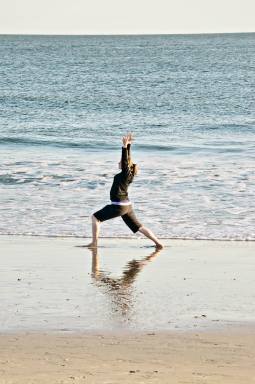At the end of my teacher training (and beginning of my pregnancy), I started to get a little burned out on my yoga reading, so I have a pile of Yoga Journal back issues sitting around that I’ve been trying to work my way through. I recently read the December 2011 issue and was pleased to find some articles related to things I’ve been blogging about here lately, so I thought I’d share.
The first thing that really caught my attention was a short article about teaching yoga to Deaf students, since that’s a topic I’d never really thought about, but a Deaf person could walk into my yoga class anytime. There are some simple things a yoga teacher can do to make a class more accessible for a Deaf student, like making eye contact, demonstrating poses, and using touch to guide. These are easy things to do that wouldn’t disrupt my usual teaching rhythm at all but that I wouldn’t have thought of on my own, so I was grateful that this article broadened my awareness. Definitely tore that one out for future reference, and in the future I’d be really interested to learn more – the DeafYoga Foundation offers trainings and presentations on how to make simple adjustments that really help Deaf students, and I’d love to attend one.
There was an article on Chair Pose that I really appreciated, since Chair is one that I struggle with a bit (see the comments here and my write-up from last year here). They describe the alignment bit by bit – getting the top half of the body aligned correctly, then getting the lower half aligned, and then putting the two together for the full pose, which is an interesting bit of yoga dissection. I can see myself coming back to this article for reference later, since they give some good tips.
This issue of YJ also includes a moon salutation sequence as an alternate to sun salutations, which I found really interesting. I haven’t tried it yet, and it could end up being a little flowy for me, but it’s definitely something I want to try. I’ll keep you posted!
I was also really interested in the article on yoga and religion. Regular readers will recall that this is an issue I’ve done some serious thinking about here on the yoga blog. I really appreciated that YJ put together a panel to discuss this. After reading the article, I went back to the March 2012 issue that I’d read a few weeks earlier, and there were several letters from readers about this article, some of whom really liked it. One reader noted that the article might have had more depth if the panel had included some actual religious leaders (priests, nuns, rabbis), rather than just yogis, which was an interesting point. I was glad, though, that Brooke Boon, the founder of Holy Yoga, a Christian ministry group, was included on the panel. I’m really interested in the intersections of yoga with personal faith, and the article gave me some new perspectives and talking points. I wish YJ made its back issues available online.


